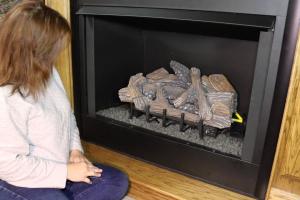Mastering the Flame: A Complete Guide on How to Light a Gas Fireplace Safely and Efficiently

-
Quick Links:
- Introduction
- Understanding Gas Fireplaces
- Safety Considerations
- Pre-Lighting Checks
- How to Light a Gas Fireplace
- Troubleshooting Common Issues
- Maintenance Tips for Gas Fireplaces
- Expert Insights
- Case Studies
- FAQs
Introduction
Gas fireplaces provide an efficient and convenient way to heat your home, creating a cozy atmosphere with minimal effort. However, the process of lighting a gas fireplace can be intimidating for many homeowners. In this comprehensive guide, we will walk you through the steps to safely and effectively light your gas fireplace, along with tips for maintenance and troubleshooting common issues.
Understanding Gas Fireplaces
Gas fireplaces come in various types, including vented, ventless, and direct vent models. Understanding how each type operates is crucial for safe lighting and use:
- Vented Gas Fireplaces: These require a chimney or flue to vent exhaust gases outside.
- Ventless Gas Fireplaces: These are designed to burn gas more efficiently, releasing fewer emissions but may require specific conditions to operate safely.
- Direct Vent Fireplaces: These draw air from outside for combustion and vent exhaust gases directly outside, offering high efficiency and safety.
Safety Considerations
Before lighting your gas fireplace, it’s essential to consider safety precautions:
- Always ensure proper ventilation in the area.
- Check for gas leaks using a soapy water solution.
- Keep flammable materials away from the fireplace.
- Have a carbon monoxide detector installed nearby.
Pre-Lighting Checks
Before attempting to light your gas fireplace, perform these checks:
- Verify that the gas supply is turned on.
- Inspect the pilot light and ensure it’s functioning correctly.
- Check the fireplace for any obstructions or debris.
How to Light a Gas Fireplace
Lighting a gas fireplace can vary slightly depending on the model, but the general steps are as follows:
Step-by-Step Guide
- Locate the Gas Control Valve: This is usually located near the bottom of the fireplace.
- Set to 'Pilot': Turn the gas control valve to the 'Pilot' position.
- Press the Ignition Button: If your fireplace has a push-button ignition, press it while holding down the control knob.
- Light the Pilot: Use a long lighter or match to ignite the pilot flame. Continue holding the knob down for about 30 seconds.
- Set to 'On': Once the pilot stays lit, turn the valve to 'On' to ignite the main burner.
Troubleshooting Common Issues
If you encounter problems while lighting your gas fireplace, consider the following troubleshooting tips:
- Pilot Light Won't Stay Lit: Check for dirt or clogs in the pilot assembly.
- No Gas Flow: Ensure the gas supply is open and check for leaks.
- Unpleasant Odors: Ventilate the area immediately and check for gas leaks.
Maintenance Tips for Gas Fireplaces
Regular maintenance ensures the safety and efficiency of your gas fireplace:
- Schedule annual inspections by a qualified technician.
- Clean the glass and surrounding areas regularly.
- Test the carbon monoxide detector monthly.
Expert Insights
Industry experts recommend understanding your specific gas fireplace model for optimal safety and efficiency. They also stress the importance of professional maintenance to prevent potential hazards.
Case Studies
Case studies highlight the importance of proper lighting techniques and maintenance:
Case Study 1: Homeowner Experience
A homeowner reported success after following a detailed guide on lighting a gas fireplace, significantly improving their winter heating efficiency.
Case Study 2: Safety Incident
A separate case involved a gas leak due to improper maintenance, leading to a costly repair and increased safety measures in the home.
FAQs
1. How often should I light my gas fireplace?
You can light your gas fireplace as often as you wish, but it’s recommended to do so during colder months for optimal heating.
2. What should I do if the pilot light goes out?
If the pilot light goes out, wait a few minutes before attempting to relight it. Follow the lighting instructions specific to your model.
3. Can I use a gas fireplace during a power outage?
Yes, most gas fireplaces can be operated during a power outage if they have a standing pilot light. However, check your specific model’s guidelines.
4. Is it safe to leave a gas fireplace on overnight?
It is generally not safe to leave a gas fireplace on overnight without supervision. Always turn it off when not in use.
5. How can I tell if my gas fireplace is leaking?
You can check for gas leaks using a soapy water solution; bubbles will form where there is a leak.
6. What type of gas is used in gas fireplaces?
Most gas fireplaces use natural gas or propane, depending on your home’s fuel supply.
7. Can I convert my wood fireplace to a gas fireplace?
Yes, with proper modifications and professional installation, you can convert a wood fireplace to a gas fireplace.
8. Are ventless gas fireplaces safe?
Ventless gas fireplaces are generally safe when used according to manufacturer instructions, but they may not be suitable for all homes.
9. How do I clean my gas fireplace?
Clean the glass and surrounding areas with a soft cloth and non-abrasive cleaner. Regularly check for dust and debris in the burner area.
10. What should I do if I smell gas?
If you smell gas, evacuate the area immediately and call your gas company or emergency services.
Random Reads
- How to hook up a pool vacuum
- How to hook up a vcr to a tv
- How to remove fence posts
- How to remove fireplace insert
- Turn off microsoft defender windows 10
- Turn off ad blocking google chrome
- How to share order details amazon
- How to share netflix content
- Your guide to placing fence posts in the ground
- Youtube subtitles closed captions